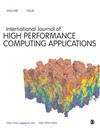ExaAM: Metal additive manufacturing simulation at the fidelity of the microstructure
IF 2.5
3区 计算机科学
Q2 COMPUTER SCIENCE, HARDWARE & ARCHITECTURE
International Journal of High Performance Computing Applications
Pub Date : 2022-01-01
DOI:10.1177/10943420211042558
引用次数: 13
Abstract
Additive manufacturing (AM), or 3D printing, of metals is transforming the fabrication of components, in part by dramatically expanding the design space, allowing optimization of shape and topology. However, although the physical processes involved in AM are similar to those of welding, a field with decades of experimental, modeling, simulation, and characterization experience, qualification of AM parts remains a challenge. The availability of exascale computational systems, particularly when combined with data-driven approaches such as machine learning, enables topology and shape optimization as well as accelerated qualification by providing process-aware, locally accurate microstructure and mechanical property models. We describe the physics components comprising the Exascale Additive Manufacturing simulation environment and report progress using highly resolved melt pool simulations to inform part-scale finite element thermomechanics simulations, drive microstructure evolution, and determine constitutive mechanical property relationships based on those microstructures using polycrystal plasticity. We report on implementation of these components for exascale computing architectures, as well as the multi-stage simulation workflow that provides a unique high-fidelity model of process–structure–property relationships for AM parts. In addition, we discuss verification and validation through collaboration with efforts such as AM-Bench, a set of benchmark test problems under development by a team led by the National Institute of Standards and Technology.在微观结构保真度的金属增材制造模拟
金属的增材制造(AM)或3D打印正在改变部件的制造,部分原因是大幅扩大了设计空间,允许优化形状和拓扑结构。然而,尽管AM所涉及的物理过程与焊接相似,焊接是一个拥有数十年实验、建模、模拟和表征经验的领域,但AM零件的鉴定仍然是一个挑战。exascale计算系统的可用性,特别是与机器学习等数据驱动方法相结合时,通过提供过程感知、局部准确的微观结构和机械性能模型,可以实现拓扑和形状优化,并加速鉴定。我们描述了组成Exascale增材制造模拟环境的物理组件,并报告了使用高分辨率熔池模拟的进展,以告知零件级有限元热机械模拟,驱动微观结构演变,并使用多晶体塑性基于这些微观结构确定本构力学性能关系。我们报告了用于exascale计算架构的这些组件的实现,以及为AM零件提供独特的过程-结构-特性关系高保真模型的多阶段模拟工作流。此外,我们还通过与AM Bench等机构的合作讨论了验证和确认问题,AM Bench是一组由美国国家标准与技术研究所领导的团队正在开发的基准测试问题。
本文章由计算机程序翻译,如有差异,请以英文原文为准。
求助全文
约1分钟内获得全文
求助全文
来源期刊
CiteScore
6.10
自引率
6.50%
发文量
32
审稿时长
>12 weeks
期刊介绍:
With ever increasing pressure for health services in all countries to meet rising demands, improve their quality and efficiency, and to be more accountable; the need for rigorous research and policy analysis has never been greater. The Journal of Health Services Research & Policy presents the latest scientific research, insightful overviews and reflections on underlying issues, and innovative, thought provoking contributions from leading academics and policy-makers. It provides ideas and hope for solving dilemmas that confront all countries.

 求助内容:
求助内容: 应助结果提醒方式:
应助结果提醒方式:


